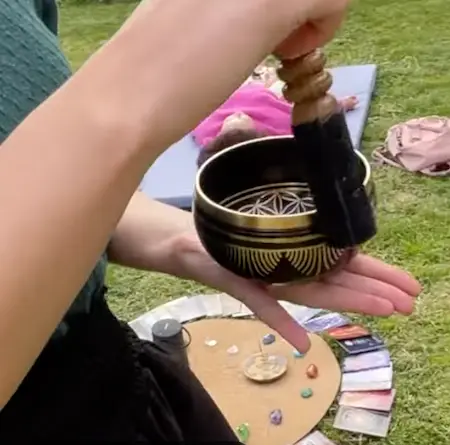This short video captures the essence of sound and frequency work: a quiet spot in nature, people on mats with eyes closed and steady breath. Sounds build arcs of tension and release them; frequencies guide the body into subtle micro-movements, impulses to stretch, and moments of letting go. The focus is not on performance but on somatic awareness and regulation.
Scene by scene: how the session unfolds
- Arriving & sensing the space: mats, blankets, cushions; a clear, safe container. Instruments like Tibetan cymbals, rattles, drum, singing bowls are visible; plus a music setup.
- Opening: the group turns attention inward. With the first sounds, relaxation becomes visible.
- The first wave: rhythmic impulses “wake” the body. Micro-movements, gentle trembling, spontaneous stretching appear — signs that the nervous system is beginning to regulate.
- Intensifying: percussive accents alternate with flowing frequencies. Some participants show emotional release (deep exhale, sighs, moist eyes) — all self-led, without directives.
- Soothing & integration: sounds widen, tempo slows. Hands rest on heart or belly, breathing evens out; the body finds rest and grounding.
Sounds and frequencies act as a field of resonance — they open a track the body follows from within.
What (doesn’t) happen here: no choreography, but body intelligence
- Energy work shows up as sensation: warmth, tingling, heaviness/lightness.
- Vibrations organize attention and tone — without force, without preset goals.
- Somatic responses are individual: stretching, turning, trembling, soft movement waves, stillness.
Why frequencies work
- Repeated frequencies synchronize inner rhythms (breath, tension/relaxation).
- The body re-orders patterns; discharge becomes possible.
- After the wave, calm consolidates the change — often supported by ground contact and breath.
Who is Innerdance for?
For people who want to explore energy work in a new way — especially if they value subtle body cues and non-verbal spaces.
Note: this practice does not replace medical or psychotherapeutic treatment.
Frequently asked questions (FAQ):
How does my body “know” how to move?
Through somatic awareness: sounds and vibrations provide stimuli; your nervous system responds with what fits right now — from stillness to movement.
Do I need prior experience?
No. Comfortable clothing and an open attitude are enough.
Which instruments/frequencies appear in the video?
Variable: e.g., singing bowls, Tibetan cymbals, rattles, drum plus sound waves from the music setup.

